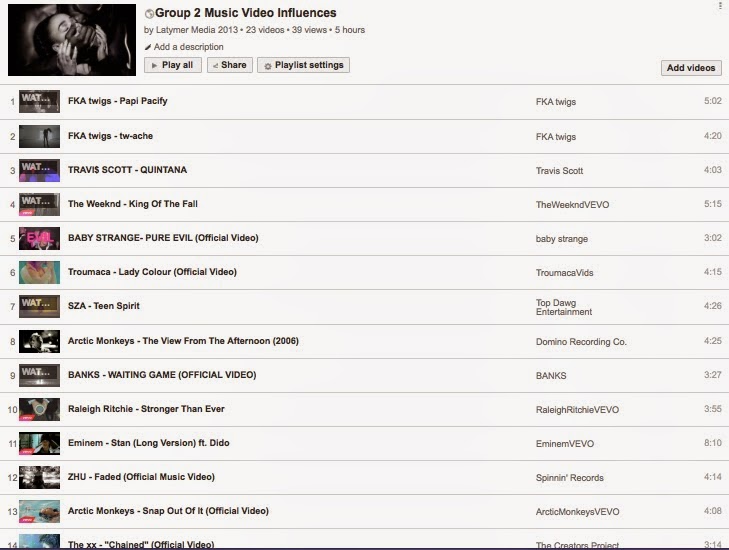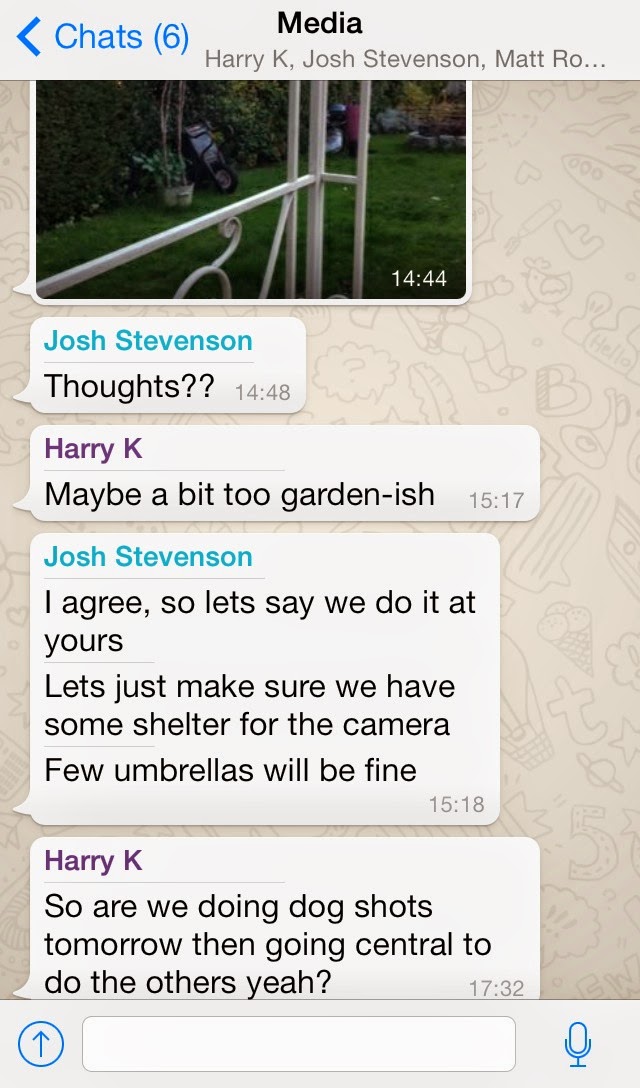Research & Planning:
Web 2.0
 |
| Entirely researched online |
.JPG) |
| Research into referential artists and 'looks' |
YouTube played a key role in finding references and inspirations in the very early stages, and throughout. As you can see below we created a playlist with ideas to help us in those early research and planning stages.
Once all of the group members were able to use iMessage through iPhones, we used this the more than the other forms of contact. iMessage allowed us to send text messages, photos, videos and audio messages, and had the immediacy of a text message. We used this to discuss key decisions, share thoughts and ideas, keep each other up to date and stay in contact.
Whatsapp was our first group chat, which is an internet based messaging system. We could send text, images, videos and audio. However I found that iMessage was more useful because Whatsapp needed the internet to even just load the chat, so if you didn't have internet you couldn't just look over the chat; as you could with iMessage as it was stored in messages on your phone.
Facebook was definitely an advantage as we could create a group page where we could store and share images, videos and documents; and get feedback through comments. However we probably used this least for discussions as there was more immediacy with iMessage & Whatsapp. We used Facebook more to store things like photos and some documents, and we used iMessage and Whatsapp for discussions.
Construction:
Web 2.0 was also key in our construction as it allowed us to create a website using wix. Wix makes website design very simple and easy, with no HTML coding to do by ourselves. It allowed us to make our website interactive and technologically converged, easily allowing us to add in text, images, videos, links and applications for things like social media. This was extremely important for our website, as we wanted to make it as technologically integrated and converged for our audience.
We also used it for the Twitter and Instagram pages of our artist, which is crucial in today's social media climate. We were able to integrate the social media profiles within each other, via links and the website, as seen below.
 | ||
| Canon 5D Mark 2 |
 |
| Canon Legria Canon 5D Mark 2 |
 |
| Canon Legria 'on the go' |
The Canon Legria HFG30 did work well on many of our other shots, like the Silhouette shots. We mainly used it for narrative shots and our shots out of the studio, because of it's portability, and easy 'point and shoot' technology.
 |
| Canon Legria filming in Oxford Street |
Editing software:
Premiere Pro
This was the software we used to edit together our music video, and various other videos for the blog construction and evaluation work. It's multi-track layout made it very easy to edit together in a non-linear format - all preferable for our music video.
 |
| Multi-track, non-linear editing format on Premiere Pro |

Premiere Pro was very useful when it came to effects and grading; I myself learnt new things like the ghosting/echo effect
I also learnt how to grade the narrative shots to make them look like past memories (particularly bad) and I was very pleased with the outcome.
Perfecting previously learnt skills, like transitions, fades and overlaying footage on top of one-another was also very useful.
Photoshop
 |
| Using the skin smoothener action on a cut out image of Roza |
[pics of before & after]
As you can see, photoshop allowed me to hide blemishes, smoothen out skin, adjust colourings, cut out unruly strands of hair and whiten the backgrounds of the shots.
 |
| Editing photos of Roza |
Photoshop also allowed us to cut out Roza's image and put it on the digipak without looking like it had been poorly cut out (as Photoshop gave precision).
 |
| Harry programming pre-sets on the lighting desk |
We were fortunate enough to have a Lighting Desk to use in the studio for the music video and publicity shots. This was a Leapfrog Lighting Desk controlling our Arri 1000k studio lights. We were taught how to use it, and pre-set out lighting set ups for each shot; which, whilst taking a fair amount of time to do, made things very easy and swift once we had the set ups.
 |
| Setting up the 5D above the projector |
Web 2.0:
Blogger:
Blogger was obviously a key component in my evaluation answers. Blogger allowed me to create and edit answers in posts and add images, videos, gifs and embed things like YouTube videos and Prezis. This allowed me to answer with interactivity and technologically converged media; giving me variation in my evaluation.Blogger:
However, I found difficulties using blogger in terms of it's format for presentation. Creating and editing the content presentation within the post was not too complicated, but the complications came when the posts were published. When they published, the presentation was different to the editing process and so it caused limitations in terms of the simplicity and precision given to make the posts ascetically pleasing.
This does not outweigh the advantages of using a blog on my coursework. Using a blog allowed for interactivity and converged technology which would otherwise be unavailable in some other formats.

Prezi
Prezi was a very useful tool to use as it gave me the ability to vary my approach to the evaluation answers. It was technologically converged so that I could use images and videos on a text presentation.
Padlet
Padlet also served a similar purpose to Prezi, but incorporated gifs into the presentation which I found more useful. However on several occasions I lost my work on Padlet due to the inability to save your work as you go along. This meant I had to re-do a lot of work, but was still a beneficial tool.
Survey Monkey
Survey Monkey is an internet based survey system which enabled our group to collect feedback from a wider variety of people. It meant we could rely on the internet's viral aspect to reach people that we wouldn't have otherwise reached as we didn't know them. We wanted a wide range of opinions to make sure that the results were as reflective and accurate as possible.I thought it was really easy to create your questions and answers specific to your survey, and the fact that you could create answers with given options and also one's where people have to comment themselves was really beneficial to our audience feedback.
Canon Legria HFG30
.JPG) |
| Filming the feedback interviews |
 We used the Legria to film our interviews, as it was easy to set up and use for a basic video of audience feedback. Premiere Pro was used to edit together all of this footage.
We used the Legria to film our interviews, as it was easy to set up and use for a basic video of audience feedback. Premiere Pro was used to edit together all of this footage.Email:
Thanks to the internet based Microsoft Outlook Web App I was able to get feedback from my teachers on my blog and evaluation work. I found this very useful as it was like a checklist to go over and ensure that I did everything.


















No comments:
Post a Comment